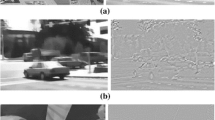Abstract
In this paper it is shown that the computation of the optical flow from a sequence of timevarying images is not, in general, an underconstrained problem. A local algorithm for the computation of the optical flow which uses second order derivatives of the image brightness pattern, and that avoids the aperture problem, is presented. The obtained optical flow is very similar to the true motion field — which is the vector field associated with moving features on the image plane — and can be used to recover 3D motion information. Experimental results on sequences of real images, together with estimates of relevant motion parameters, like time-to-crash for translation and angular velocity for rotation, are presented and discussed. Due to the remarkable accuracy which can be achieved in estimating motion parameters, the proposed method is likely to be very useful in a number of computer vision applications.
Similar content being viewed by others
References
Bertero M, Poggio T, Torre V (1988) Ill-posed problems in early vision. In: Proceedings of IEEE on Computer Vision, (in press)
Enkelmann W (1986) Investigation of multigrid algorithms for the estimation of optical flow fields in image sequences. In: Proceedings Workshop on Motion: Representation and Analysis, Charlestone, SC, pp 81–87
Fenmena CL, Thompson WB (1979) Velocity determination in scenes containing several moving objects. Comput Graph Image Proc 9:301–315
Gibson JJ (1950) The perception of the visual world. Houghton Mifflin, Boston
Haralick RM, Lee JS, (1983) The facet approach to optic flow. In: Baumann LS (eds) Proceedings image understanding workshop. Science Applications, Arlington Va, pp 84–93
Heeger DJ (1987) Optical flow from spatiotemporal filters. In: Proceedings First International Conference on Computer Vision, London, pp 181–190
Hildreth EC (1984a) The measurement of visual motion. MIT Press, Cambridge London
Hildreth EC (1984b) The computation of the velocity field. Proc R Soc London B 221:189–220
Hirsh MW, Smale S (1974) Differential equations, dynamical systems, and linear algebra. Academic Press, New York
Horn BKP, Schunck BG (1981) Determining optical flow. Artif Intell 17:185–203
Kanatani K (1985) Structure from motion without correspondence: general principle. In: Proceedings of the Image Understanding Workshop, Miami, pp 110–116
Koenderink JJ, Doom AJ van (1977) How an ambulant observer can construct a model of the environment from the geometrical structure of the visual inflow. In: Hauske G, Butendant E (eds) Kibernetic 1977. Oldenbourg, München
Longuet-Higgins HC, Prazdny K (1980) The interpretation of a moving retinal image. Proc R Soc London B 208:385–397
Marr D (1982) Vision. Freeman, New York
Nagel H-H (1983) Displacement vectors derived from second order intensity variations in image sequences. Comput Vision Graph Image Process 21:85–117
Nagel H-H (1986) Image sequences-ten(octal)years-from phenomenolgy towards a theoretical foundations. In: Proceedings of the Eighth International Conference on Pattern Recognition, Paris, pp 1174–1185
Nagel H-H (1987) On the estimation of optical flow: relations between different approaches and some new results. Artif Intell 33:299–324
Poggio T, Torre V, Koch C (1985) Computational vision and regularization theory. Nature 317:314–319
Reichardt W, Schlögl RW, Egelhaaf M (1988) Movement detector of the correlation-type provide sufficient information for local computation of 2D velocity field. Naturwissenschaften 75:313–315
Tretiak O, Pastor L (1984) Velocity estimation from image sequences with second order differential operators. In: Proceedings of the International Conference on Pattern Recognition, Montreal, Que, pp 16–19
Tsai RY, Huang TS (1982) Uniqueness and estimation of three-dimensional motion parameters of rigid objects with curved surfaces. University of Illinois at Urbana-Champaign Coordinated Science Laboratory Report R-921
Ullmann S (1979) The interpretation of visual motion. MIT Press, Cambridge London
Ullmann S (1983) Recent computational studies in the interpretation of structure from motion. In: Rosenfeld A, Beck J (eds) Human and machine vision. Academic Press, New York
Verri A, Poggio T (1987) Against quantitative optical flow. In: Proceedings of the First International Conference on Computer Vision, London, pp 171–180
Waxman AM (1984) An image flow paradigm. In: Proceedings of the Workshop on Computer Vision: Representation and Control, Annapolis: IEEE, pp 49–57
Waxman AM, Ullmann S (1983) Surface structure and 3D motion from image flow: a kinematic analysis. University of Maryland Computer Science Technical Report CS-TR-1332
Westphal H, Nagel H-H (1986) Toward the derivations of three-dimensional descriptions from image sequences for nonconvex moving objects. Comput Vision Graph Image Process 24:302–320
Author information
Authors and Affiliations
Rights and permissions
About this article
Cite this article
Uras, S., Girosi, F., Verri, A. et al. A computational approach to motion perception. Biol. Cybern. 60, 79–87 (1988). https://doi.org/10.1007/BF00202895
Received:
Issue Date:
DOI: https://doi.org/10.1007/BF00202895




